Case 1 - Dwarf Hamster. Ineffective medicine for hamster's chest swelling?
"Did Vet 1 say that the hamster's swelling or tumour will disappear after eating the drops of oil put inside its food or water?" the lady in her 30s showed me a small brown bottle of oil and a tube of eye ointment given by Vet 1.
The
bottle had some medication for rodents and a
heading in bold letters saying "Neoplasia,
mammary tumours and tissue indurations".
The label advised 5 drops should be given to
the hamster per day for "several weeks until
symptoms are seen to ease off".
"No," she shook her head. "My brother thinks
that such medication is ineffective. I did not
comment further.
"My advice is to anaesthesize the hamster and
check out the swelling," I said. The swelling
in the chest was firm. The hamster squeaked
loudly the first time I palpated it and did
not mind at later palpations. It felt tense
like a balloon. Could it be a haematoma full
of blood or a tumour?
As the hamster is easily stressed, I did not
restrain it further. The owner had consulted
me yesterday about this swelling after
visiting Vet 1 and seeing no improvement in
the swelling after a few days. She had
consulted family members before deciding on
anaesthesia and surgery for the hamster's
chest swelling.
"Will my hamster die under anaesthesia?" she
asked.
"No vet can guarantee that a hamster will be
risk free under anaesthesia. I do have
hamsters dying during anaesthesia. However,
healthy and active hamsters seldom die."
When the vet thinks that the case is high risk
for general anaesthesia, the patient dies.
When the patient looks like a poor bet, he
survives. So, I stop making predictions.
There is
so much ill will when the hamster dies on the
operating table. Sometimes, it is better to
ask the owner to look for another vet if
anaesthesia and surgery is required rather
than prescribing some medication.
Many owners want instant cures and
conservative treatment may take a long time.
What Singapore pet owner wants is an
instant cure. No excuses.
In this case, the dwarf hamster had an
additional problem - a stye on its upper
eyelid of the left eye. Eye ointment might be
effective in this case if given time. However,
the hamster rubbed its eye daily and eye tears
and hair loss become evident. As this eye
abscess had "pointed" by the time I was
consulted, I was fortunate. Incision and
drainage of the stye and the haematoma
resolved this hamster's problems. If the eye
abscess had not "ripened", the owner would
have to wait a few days.
In conclusion, the vet is judged by performance. Confidence in the vet vaporises if the case is not satisfactorily treated. It is better to ask the owner to seek another veterinarian if the vet does not want to risk deaths on the operating table. A diversity of services sustains the profitability of the practice. The interest of the patient may conflict with economics of the practice many times and this is the veterinary dilemma of private practice.
Case
2 - Syrian Hamster. Is treatment necessary for
the hamster's chest swelling?
"A Syrian hamster costs $18.00 but the
veterinary treatment definitely costs much
more," the young lady told me that her mother
was not in favour of getting the hamster to
the veterinarian.
The hamster did not seem to be bothered with
the large chest swelling. I palpated it. There
was no painful squeaks. It was much firmer
than the haematoma. The hamster was 1.5 years
old and therefore a tumour was possible. The
swelling was not reddish unlike the above case
and therefore a haematoma with blood
accumulating inside was unlikely.
I could insert a needle into the swelling to
aspirate the fluid. However, hamsters move
around and their front paws swipe and sweep
away any obstacles. The owner may get upset
with all these manipulations causing stress to
the hamster. Stress of handling and restraint
may just kill him in front of the owner.
The treatment was incision and drainage under
general anaesthesia. This Syrian hamster is at
least 8 times bigger than the dwarf. After
sedation and anaesthesia, I incised the chest
swelling with a scalpel. Greenish yellow pus
oozed out. The operating room had a strong
foul decaying smell. At least 2 ml of
malodorous pus was squeezed out from the chest
muscles.
No stitching was done so as to get the
residual pus to drain out. This hamster was
fortunate to have a lady owner who got him
treated in time. The decay in his chest muscle
due to necrotic bacteria would have killed him
if his immune system could not battle the
invading bacteria. How did he get his
infection? I don't know.
He was alive and would live to the end of his
life as his toxic pus had been drained.
Conclusion of the 2 cases.
Two hamsters. Two chest swellings. The
hamsters were past 1 year of age. The
swellings were firm and solid. The dwarf
hamster's haematoma had a reddish skin but the
redness could be due to the hamster scratching
it.
The Syrian hamster's encapsulated abscess also looked red if you see the picture below. Anaesthesia and surgery are necessary to resolve the case to the satisfaction of the owner and probably her mother. Surprising none of the two hamsters had tumours.
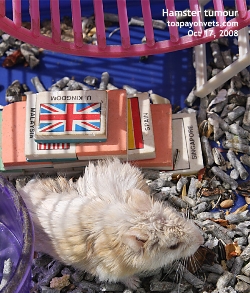 Medical
treatment is usually ineffective in the
treatment of many hamster tumours. Prescribing
oil medications may be homeopathy. However,
they will not work in large skin swellings
which may burst and get infected (cellulitis)
if not incised and drained surgically early.
Some develop into gigantic tumours (image,
left) or into big infected warts/tumours (as in the
hamster case from Beijing, see case below.)
Medical
treatment is usually ineffective in the
treatment of many hamster tumours. Prescribing
oil medications may be homeopathy. However,
they will not work in large skin swellings
which may burst and get infected (cellulitis)
if not incised and drained surgically early.
Some develop into gigantic tumours (image,
left) or into big infected warts/tumours (as in the
hamster case from Beijing, see case below.)
In this internet age, the younger owners know
where to source for information. In this
litigious society, it is best to refer the
owner to other vets if one if not comfortable
with handling of such cases. For similar
reasons, I reject avian and fish cases and ask
the owners to seek other vets.

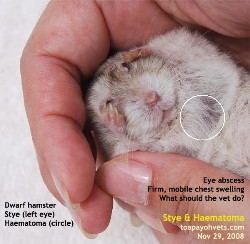
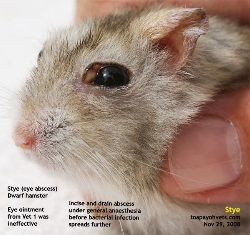
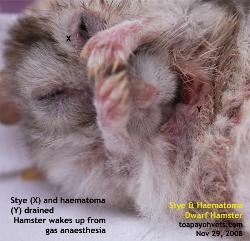
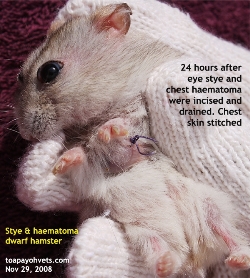
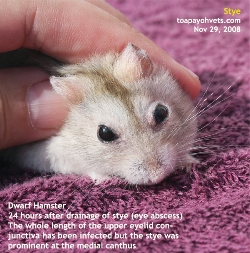
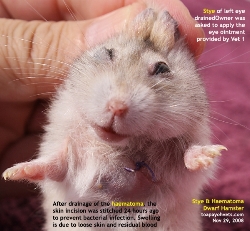
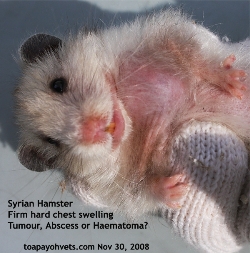
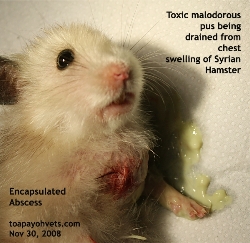
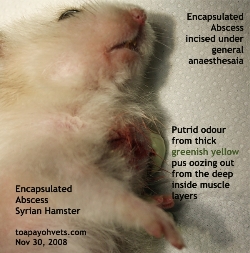
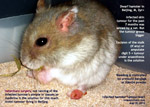

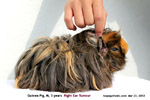
 Toa
Payoh Vets
Toa
Payoh Vets